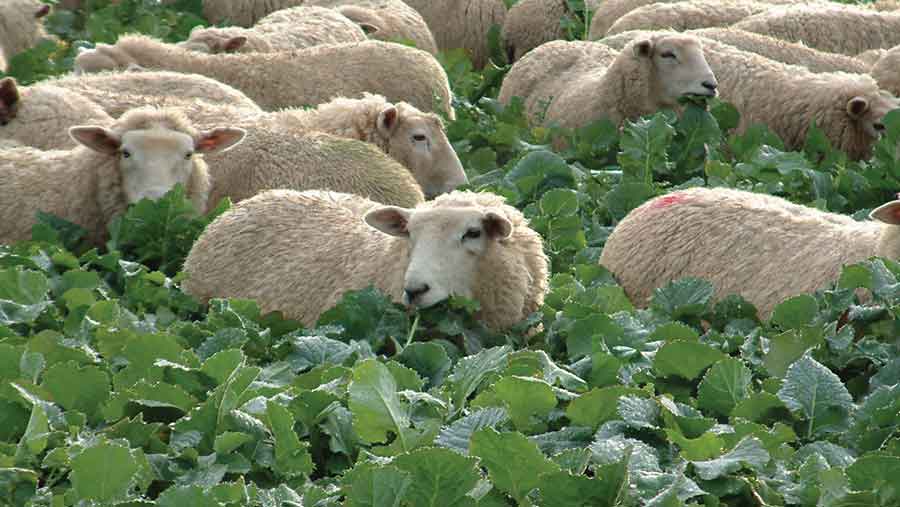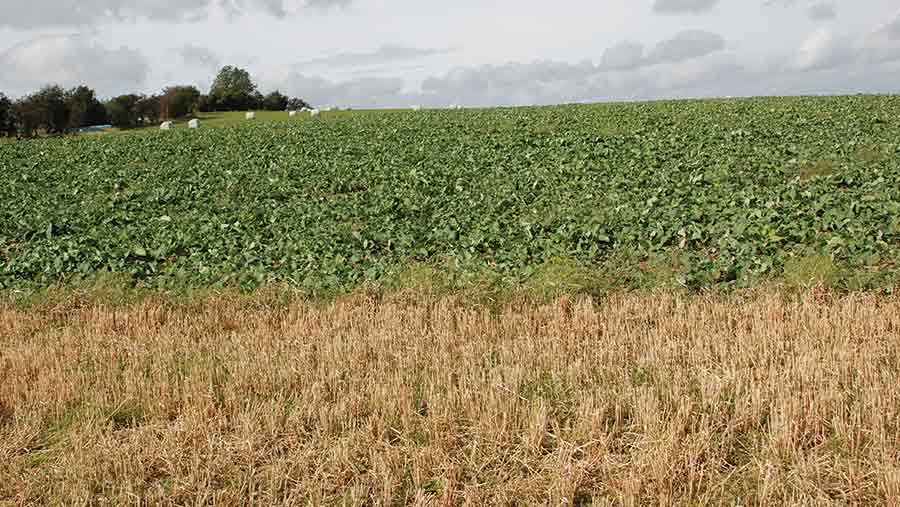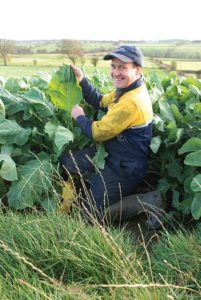7-step guide to planting brassica crops

Winter brassica crops are becoming an increasingly popular option as livestock producers look to reduce production costs.
Germinal GB consultant Helen Mathieu and AHDB livestock scientist Liz Genever came up with some establishment tips for growers.
Forage crops can provide a cheap source of winter feed. Outwintering livestock can relieve pressure on housing and cut labour and bedding costs. And feed value is high at 15%-18% protein and 70% energy – equivalent to a good-quality silage.
The quality and savings on costs make forage crops a relatively cheap food source at about 4p-5p/kg dry matter (DM). That compares with an equivalent silage at 12p/kg DM and barley at about 15p/kg DM.
Forage crops also provide a break in grass rotations. But it is important to remember they may not suit every farm. Farmers must consider the suitability of soil, weather and topography.
1. Choosing a crop
Most types of brassicas can be grazed by sheep or cattle. So the starting point in choosing which forage crop to grow is to decide when it needs to be ready for grazing and to work back from there (see table below).

Traditionally, forage crops have fitted into two groups – winter-hardy main crops such as kale and swede, or faster-growing rapes and stubble turnips.
Feed intakes
- Kale has about 12-15% DM, so a sample weighing 6-8kg provides 0.75kg DM/sq m
- If a 500kg cow needs 10kg DM/day, one cow will get through 13sq m of kale
- Kale can provide 10t DM/ha, so 1ha can feed 100 cows for one week. For sheep, a rough guide is 1ha to feed 500 ewes each week
- Stubble turnips or rape have half the dry matter level of kale at about 5-6t DM/ha, so 2ha feeds 100 cows a week. Hybrid varieties fall roughly midway between the two
Main crops need 10 months in the ground to maximise yields.
These are normally used for outwintering cattle or sheep.
Rapes and turnips require six months’ growth to reach peak yields.
But these can be grazed just eight weeks after sowing to bolster feed when grass growth drops off in late summer.
See also: Outwintering dairy heifers on Kale helps cut costs
There is also now a third crop group. Hybrid rape-kales are winter hardy and aggressive growers.
These are ready to graze in 10-15 weeks. Their rapid growth also allows more than one grazing in a season.
Other considerations
- Yield (specifically usable yield)
- Disease resistance
- Digestibility of stems/bulbs/leaves
- Leaf-to-stem ratio
- Regrowth ability
- Winter hardiness
- Growing height
- Versatility
- Feeding
(Source: AHDB)
2. Choosing a field
Fields have to be free-draining without being too steep, particularly for winter grazing.
There should be no threat to watercourses from run-off or agrochemicals. Stock will need protecting from harsh weather, so fields with shelter from trees or hedges are ideal.
On well-organised strip- or block-grazing systems, pressure on soil is surprisingly light. That is because the livestock are standing on fresh soil as the fences are moved or blocks opened up.
Careful management here will maximise the crop’s potential. Some sheep units allow the whole run of a field. But a block-grazing system prevents trampling, leaving forage more palatable and easier to graze.
3. Preparation
Soils should be tested to assess pH levels and nutrients. Phosphate is vital but its availability is limited in acidic soils of pH5.8 or below.
Fast-acting lime will be needed to address this. Some livestock keepers choose not to plough, opting for direct drilling instead to maintain a firmer surface.
However, ploughing and glyphosate may still be necessary if a thatch from the previous grass sward has persisted. This must be broken down to allow the seed to reach the soil.
It is also wise to provide an uncultivated run-back area for stock. Silage or straw bales should be placed at strategic points while the soil is still firm to provide roughage alongside the forage. This reduces the need to drive on fields in wet winter months.

4. Sowing
Good seed-to-soil contact is vital for germination. The seed is drilled at depths of only about 1cm.
The key is to have a dense crop, so seed rates need to be kept up. Too low a rate and the plants will grow thicker stalks, which are of less nutritional value than the leaf.
Kale, rape and turnips can be sown at 6kg/ha or broadcast at a higher rate of 7.5kg/ha. Swede has a different type of seed and should be precision drilled at 1.2kg/ha.
5. Pest, weed and disease control
If the seed-bed is well enough formed and treated with glyphosate before drilling, it will decrease the weed pressure.
The broad-leafed weed fat hen can cause problems, but spraying will not always be cost-effective. The main disease to avoid in brassica crops is clubroot.
The field needs to be left for five years between brassica crops to prevent the disease from establishing. Once it is present, it will devastate the crop.
Slugs are the most common pest and cause considerable damage. Slug pellets can be drilled along with the seed to control populations.
6. Fertiliser requirements
The bulk of the fertiliser goes into the seed-bed for early-summer-sown crops. A standard nitrogen (N), phosphate (P), potash (K) fertiliser ratio such as 20:10:10 can be used.
Most grassland farms will use this on pasture, so it will be readily available. However, forage crops respond well to phosphate. A more appropriate fertiliser ratio and application rates are:
- Phosphate 60-80kg/ha
- Potash 60-80kg/ha
- Nitrogen 80-90kg/ha
Nitrogen application rates depend on the sowing date. In the summer, crop growth rates are higher, so N rates should be increased.
Kale will also respond better to nitrogen when leaves are growing. Therefore, with kale it is best to split applications, with half the nitrogen applied as a top dressing six to eight weeks after sowing.
As the soil temperatures drop, the crop yield potential declines and the N requirement falls.
7. Managing feed intakes
The aim is to provide a long feed face, moved back in short steps. This gives more cattle the opportunity to graze freely, the crop is fresher and the pressure on soil is minimised.
To manage the crop and match it to livestock growth requirements, it is essential to obtain a measure of the feed available. It is a simple process. At stages along the feed face livestock keepers should cut and weigh a square metre off the crop.
Case study: Tony Wilson, West High Wood Farm

Tony Wilson
A switch to brassica crops has halved winter feed and housing costs for one upland beef producer.
Tenant farmer Tony Wilson (pictured) manages West High Wood Farm, a 120ha hill farm near Barnard Castle, County Durham.
Mr Wilson decided to outwinter cows on forage because of the rising costs associated with keeping the herd indoors in his cubicle shed.
The 70 continental-cross suckler cows calve in May and June and the calves are housed in November. But the cows are outwintered on 6ha of kale, with silage for roughage.
Stocking rates are 7.5 cows a hectare and the kale is strip-grazed using an electric fence.
The system’s simplicity is one of its main selling points, as far as Mr Wilson is concerned.
“It’s a far easier job to shift the fence back twice a day than bedding up, feeding round and mucking out housing,” he says.
The strip-grazing progresses down the fields, with a well-drained grass run-back area left at the top.
Straw and silage bales provide the fibre needed to balance the highly digestible kale. The bales are placed in advance to cut the need to drive on to the field in winter.
Kale is grown two years in succession as part of an eight-year grass reseeding rotation.
Mr Wilson uses Maris Kestrel kale, an older semi-dwarf variety.
“Taller varieties grew higher than the fence and cows dragged it on to the electric wire getting a shock in the process,” he explains.
But the variety does have good leaf growth and a high leaf-to-stalk ratio. That is important because the leaf is of more nutritional value, he says.
| West High Wood cost comparison | |
| Outdoor ration cost | |
| Usable feed | 10t DM/ha |
| Growing costs (including fertiliser, fieldwork and seed) | £221.25/ha or 2.2p/kg DM |
| Outdoor feeding costs for a dry cow eating 9kg DM/day |
|
| Total cost | 32p a cow a day |
| Previous indoor ration cost | |
| Equivalent silage, straw and mineral diet | 61p a cow a day |
| Saving (feed costs alone) |
29p/day. £35 a cow over 120-day feed period |
| Herd saving (70 cows) | £2,450 |
